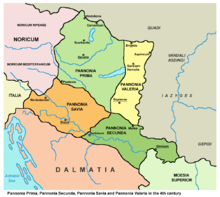Pannonia Prima
| Provincia Pannonia Prima | |||||||||
|---|---|---|---|---|---|---|---|---|---|
| province of the Roman Empire | |||||||||
| 296–5th century | |||||||||
 | |||||||||
| Capital | Savaria | ||||||||
| History | |||||||||
• Established | 296 | ||||||||
• Disestablished | 5th century | ||||||||
| |||||||||
| Today part of | Hungary, Austria, Croatia, Slovenia | ||||||||
Pannonia Prima was an ancient Roman province. It was formed in the year 296, during the reign of Emperor Diocletian. Previously, it was a part of the province of Pannonia Superior, which, along with Pannonia Inferior, was gradually divided into four administrative units: Pannonia Prima, Pannonia Secunda, Valeria, and Savia. This transition was completed by the time of Constantine.[1] According to the Notitia Dignitatum, Pannonia Prima was governed by a Praeses.
Geography
Pannonia Prima included parts of present-day Hungary, Austria, Croatia, Slovenia, and Slovakia. Its capital was Savaria (modern Szombathely), a city built during the reign of Claudius. This city was located on an important junction between the Amber Road connecting Italy with Hungary and the road between Treveris and Sirmium.[2] Other important cities were Vindobona (modern Wien - Vienna), and Scarbantia (modern Sopron).[3] The city of Sirmium in Pannonia Secunda had administrative oversight over all of the newly created Diocese of Pannonia, along with Dalmatia and Noricum.[4]
Pannonia Prima was the northwestern quadrant of the four subdivisions of Pannonia. It was bordered on the west by the Alps, which stretch from the Danube River to the Adriatic Sea, and belonged to the provinces of Noricum.[5] It is bordered on the north by the Danube and on the south by the Drava river. In the east, it is divided from Valeria by an arbitrary north-south border which is tangent to the east end of lacus Pelso (Lake Balaton).[6] On the other hand, was the fort of Valcum (modern Fenékpuszta), close to the Sirmium-Savaria road. This fort is dated to the Constantian era, and is a center of imperial latifundia. The only Pannonian frontier border was that of the Danube, and it was easily defensible; thus, there were few forts lining that border.[7]
Decline and Fall
Emperor Gratian (367-383) began settling Huns as foederati in Pannonia.[8] Roman money had ceased circulating in all Pannonia north of the Drave (including Pannonia Prima) by 375, indicating that little Roman influence remained in the area. The foederati and Visigothic and Hunnic barbarians caused trouble, and the situation in Pannonia was described by Claudian as “a continual siege” in 399. Pannonia Prima held out under Generidus, but was eventually assimilated into the Huns' territory by 427. Rome would never regain control of this area, but remained a Roman province, until the fall of the Ostrogothic Kingdom in 553.[9]
References
- ^ Mocsy, A: "Pannonia and Upper Moesia", pp. 272-3. Boston: Routledge and Kegan Paul Ltd., 1974
- ^ Poczy, K: "Pannonian Cities", in "The Archaeology of Roman Pannonia", eds. Radan, G.T.B. and A. Lengyel, p. 243. Budapest: Akadémiai Kiadó, 1980.
- ^ Mocsy, A: "Pannonia and Upper Moesia", fig. 59. Boston: Routledge and Kegan Paul Ltd., 1974
- ^ Barkoczi, L: "History of Pannonia", in "The Archaeology of Roman Pannonia", eds. Radan, G.T.B. and A. Lengyel, p. 109. Budapest: Akadémiai Kiadó, 1980.
- ^ Strabo's Geography, Section VII, Chapter 5, Section 3
- ^ Mocsy, A: "Pannonia and Upper Moesia", fig. 59. Boston: Routledge and Kegan Paul Ltd., 1974
- ^ Mocsy, A: "Pannonia and Upper Moesia", pp. 302-307. Boston: Routledge and Kegan Paul Ltd., 1974
- ^ Salamon, A, and A. Cs. Sos: "Pannonia - Fifth to Ninth Centuries", in "The Archaeology of Roman Pannonia", eds. Radan, G.T.B. and A. Lengyel, p. 397. Budapest: Akademiai Kiado, 1980.
- ^ Mocsy, A: "Pannonia and Upper Moesia", pp. 342-349. Boston: Routledge and Kegan Paul Ltd., 1974
- States and territories established in the 290s
- States and territories disestablished in the 5th century
- Roman Croatia
- Ancient history of Slovenia
- Roman Illyria
- States and territories established in 296
- Provinces of Pannonia
- Late Roman provinces
- 296 establishments in the Roman Empire
- 296 establishments in Europe
- 5th-century disestablishments in Europe
- 5th-century disestablishments in the Roman Empire
